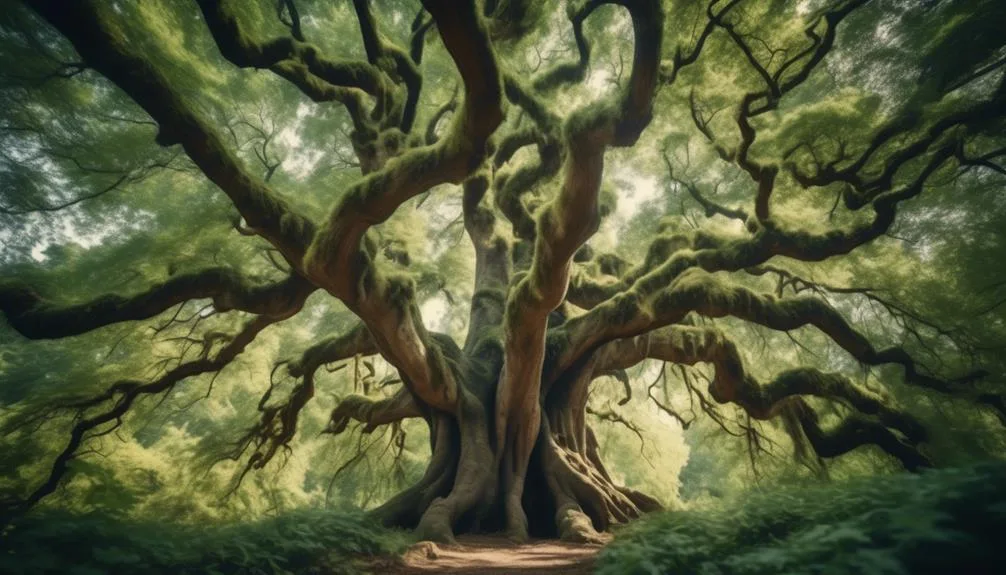The world is home to ancient elm trees that have witnessed centuries of history and still flourish in North America, Europe, Asia, Oceania, and Africa. These remarkable giants hold secrets within their gnarled trunks.
But where exactly can you find these living relics of the past, and what makes them so special? Join us as we explore the fascinating journey of the world's oldest elm trees and the stories they have to tell.
Oldest Elm Trees in North America
Discover the majestic history and enduring legacy of the oldest elm trees in North America, standing as living testaments to the passage of time and the resilience of nature.
These magnificent trees have witnessed centuries of history and are revered for their age and grandeur.
Age determination of North American elm trees is a fascinating process, often requiring dendrochronology and carbon dating to accurately assess their age.
The oldest elm species in North America, such as the majestic Ulmus americana, have been the focus of extensive preservation efforts due to their cultural and ecological significance.
Conservationists and botanists work tirelessly to protect these ancient trees from threats such as Dutch elm disease, ensuring that future generations can continue to marvel at the splendor of these living natural wonders.
Ancient Elm Trees in Europe
Standing majestically across the European landscape, ancient elm trees exude a timeless grandeur that captivates all who behold their enduring presence. European elm conservation efforts are crucial in preserving these magnificent trees, which have faced threats from Dutch elm disease and habitat loss.
In various European countries, conservation initiatives aim to protect and restore the populations of these iconic elms, ensuring their continued presence for future generations to admire.
Moreover, elm tree folklore is deeply rooted in European culture, with these trees often symbolizing strength, resilience, and protection. Throughout history, elms have been featured in folklore, art, and literature, representing enduring wisdom and connection to the natural world.
Exploring the ancient elm trees in Europe not only provides a glimpse into the continent's natural history but also offers insights into the cultural significance of these remarkable trees.
Historic Elm Trees in Asia
The ancient elm trees of Europe have long been celebrated for their cultural significance and resilience, and now, our focus shifts to the historic elm trees found across the diverse landscapes of Asia. Asia is home to some of the oldest and most majestic elm trees, including ancient Chinese elms and historic Japanese elms. These trees have stood the test of time, witnessing centuries of history and cultural change.
To give you a glimpse of these magnificent elm trees in Asia, here's a snapshot:
| Location | Species | Age |
|---|---|---|
| Beijing, China | Ancient Chinese Elms | Over 500 years old |
| Kyoto, Japan | Historic Japanese Elms | Around 300 years old |
| Seoul, South Korea | Ancient Korean Elms | Over 400 years old |
| Taipei, Taiwan | Majestic Taiwanese Elms | Nearly 600 years old |
| Hanoi, Vietnam | Timeless Vietnamese Elms | Over 200 years old |
These ancient trees continue to inspire awe and reverence, standing as living testaments to the rich history and natural beauty of Asia.
Legacy Elm Trees in Oceania
In Oceania, you'll encounter magnificent elm trees that have woven themselves into the tapestry of the region's landscapes, embodying a legacy of endurance and natural splendor. These legacy elm trees hold immense environmental significance and are an integral part of indigenous preservation efforts.
When exploring Oceania, be sure to seek out these remarkable trees and consider their importance in the region's ecosystem. Indigenous Preservation: Legacy elm trees in Oceania are deeply intertwined with indigenous cultures and hold significant spiritual and historical value for local communities.
Environmental Significance: These trees play a crucial role in maintaining the ecological balance of Oceania's diverse landscapes, contributing to biodiversity and habitat preservation.
Natural Splendor: The beauty of these elm trees adds to the allure of Oceania's natural scenery, offering a serene and picturesque backdrop to the region's landscapes.
Endurance: These ancient trees serve as a testament to the enduring power of nature, standing tall through the passage of time and embodying resilience in the face of environmental challenges.
Timeless Elm Trees in Africa
Amidst the vast African landscapes, you'll discover timeless elm trees that have stood as enduring symbols of nature's resilience and beauty for generations.
In Africa, these majestic elms hold profound cultural significance, deeply rooted in local traditions and folklore. Conservation efforts are underway to protect these ancient elms, preserving their historical and ecological importance.
The preservation of these timeless elm trees is crucial, not only for their intrinsic value but also for the vital role they play in maintaining the delicate balance of the African ecosystem. These ancient elms serve as a living testament to the enduring power of nature and the need for sustainable conservation practices.
As you explore the African plains, take a moment to appreciate the profound legacy of these timeless elm trees, standing tall against the test of time.
Conclusion
Wherever you may be, these ancient elm trees stand as a testament to the enduring power of nature and the passage of time.
From the historic trees of Europe to the majestic elms in Central Park, they invite us to contemplate the beauty and resilience of our natural world.
Happy exploring!

My interest in trees started when I first saw the giant sequoias in Yosemite.
I was a teenager then, and I remember thinking, “I need to learn more about this.”
That moment stuck with me.
A few years later, I went on to study forestry at Michigan Tech.
Since graduating, I’ve worked in a mix of hands-on tree care and community education.
I’ve spent over ten years helping people understand how to plant, maintain, and protect the trees in their neighborhoods.
I don’t see trees as just part of the landscape.
They are living things that make a real difference in our daily lives.
